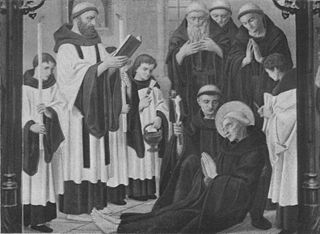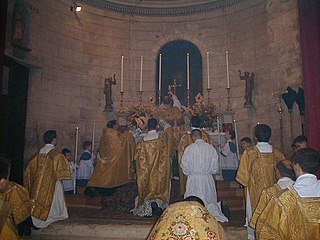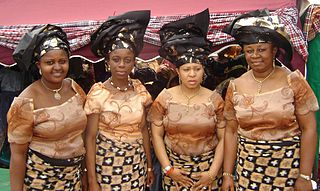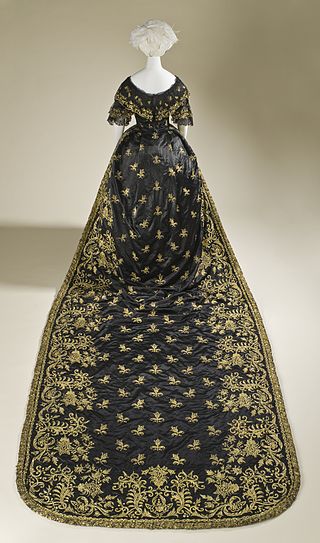
A surplice is a liturgical vestment of Western Christianity. The surplice is in the form of a tunic of white linen or cotton fabric, reaching to the knees, with wide or moderately wide sleeves.

The cassock or soutane is a Christian clerical clothing coat used by the clergy and male religious of the Oriental Orthodox Churches, Eastern Orthodox Church and the Catholic Church, in addition to some clergy in certain Protestant denominations such as Anglicans and Lutherans. "Ankle-length garment" is the literal meaning of the corresponding Latin term, vestis talaris. It is related to the habits traditionally worn by nuns, monks, and friars.

Vestments are liturgical garments and articles associated primarily with the Christian religion, especially by Eastern Churches, Catholics, Lutherans, and Anglicans. Many other groups also make use of liturgical garments; among the Reformed (Calvinist) Churches this was a point of controversy in the Protestant Reformation and sometimes since, in particular during the ritualist controversies in the Church of England in the 19th century.

A hood is a type of headgear or headwear that covers most of the head and neck, and sometimes the face. Hoods that cover mainly the sides and top of the head, and leave the face mostly or partly open may be worn for protection from the environment, for fashion, as a form of traditional dress or uniform, or in the case of knights, an armoured hood is used for protection against bladed weapons. In some cases, hoods are used to prevent the wearer from seeing where they are going. Hoods with eye holes may be used for religious purposes to prevent the wearer from being seen. In the case of Ku Klux Klan members, terrorists, or criminals such as robbers, a hood with eye holes helps prevent identification.

A kaftan or caftan is a variant of the robe or tunic. Originating in Asia, it has been worn by a number of cultures around the world for thousands of years. In Russian usage, kaftan instead refers to a style of men's long suit with tight sleeves.

A chemise or shift is a classic smock type of women's undergarment or dress. Historically, a chemise was a simple garment worn next to the skin to protect clothing from sweat and body oils, the precursor to the modern shirts commonly worn in Western nations.

A tunic is a garment for the body, usually simple in style, reaching from the shoulders to a length somewhere between the hips and the knees. The name derives from the Latin tunica, the basic garment worn by both men and women in Ancient Rome, which in turn was based on earlier Greek garments that covered wearers' waists.

The Geneva gown, also called a pulpit gown, pulpit robe, or preaching robe, is an ecclesiastical garment customarily worn by ordained ministers and accredited lay preachers in the Christian churches that arose out of the historic Protestant Reformation. It is particularly associated with Protestant churches of the Reformed, Methodist, Unitarian and Free Christian traditions.

A bathrobe, also known as a housecoat or a dressing gown, is a loose-fitting outer garment worn by people, often after washing the body or around a pool. A bathrobe is considered to be very informal clothing, and is not worn with everyday clothes.

A chimere is a garment worn by Anglican bishops in choir dress, and, formally as part of academic dress.
A gaberdine or gabardine is a long, loose gown or cloak with wide sleeves, worn by men in the later Middle Ages and into the 16th century.
Clerical clothing is non-liturgical clothing worn exclusively by clergy. It is distinct from vestments in that it is not reserved specifically for use in the liturgy. Practices vary: clerical clothing is sometimes worn under vestments, and sometimes as the everyday clothing or street wear of a priest, minister, or other clergy member. In some cases, it can be similar or identical to the habit of a monk or nun.

A dressing gown, housecoat or morning gown is a robe, a loose-fitting outer garment, worn by either men or women. They are similar to a bathrobe but without the absorbent material.

The wrapper, lappa, or pagne is a colorful garment widely worn in West Africa by both men and women. It has formal and informal versions and varies from simple draped clothing to fully tailored ensembles. The formality of the wrapper depends on the fabric used to create or design it.

A gown, from the Saxon word, gunna, is a usually loose outer garment from knee-to-full-length worn by men and women in Europe from the Early Middle Ages to the 17th century, and continuing today in certain professions; later, the term gown was applied to any full-length woman's garment consisting of a bodice and an attached skirt. A long, loosely fitted gown called a Banyan was worn by men in the 18th century as an informal coat.

A banyan is a garment worn by European men and women in the late 17th and 18th century, influenced by the Japanese kimono brought to Europe by the Dutch East India Company in the mid-17th century. "Banyan" is also commonly used in present-day Indian English and other countries in the Indian subcontinent to mean "vest" or "undershirt".

A khalat, also known as khelat, is a loose, long-sleeved outer silk or cotton robe common in Central Asia and South Asia and worn both by men and women, although in differing styles.

In clothing, a train describes the long back portion of a robe, coat, cloak, skirt, overskirt, or dress that trails behind the wearer.

The boubou or grand boubou is a flowing wide-sleeved robe worn across West Africa, and to a lesser extent in North Africa, related to the dashiki suit.

Thawb or thobe is an Arab dress for the inhabitants of the Arabian Peninsula, also called dishdashah, and kandurah, kandoora or gandurah in varieties of Arabic. A long-sleeved ankle-length traditional robe, it is mainly worn by men in the Arabian Peninsula, Jordan, Syria, Palestine, Lebanon, North Africa, and some countries in East and West Africa, with regional variations in name and style. It is also worn by Muslim men in the Indian subcontinent due to its modest appearance, and is referred to as jubbah. Depending on local traditions, a thawb can be worn in formal or informal settings; in the Gulf states thobes are the main formal attire for men. The term "thobe" is used is also used in some varieties of Arabic to refer to women's attire, such as in Palestine and Sudan.





















